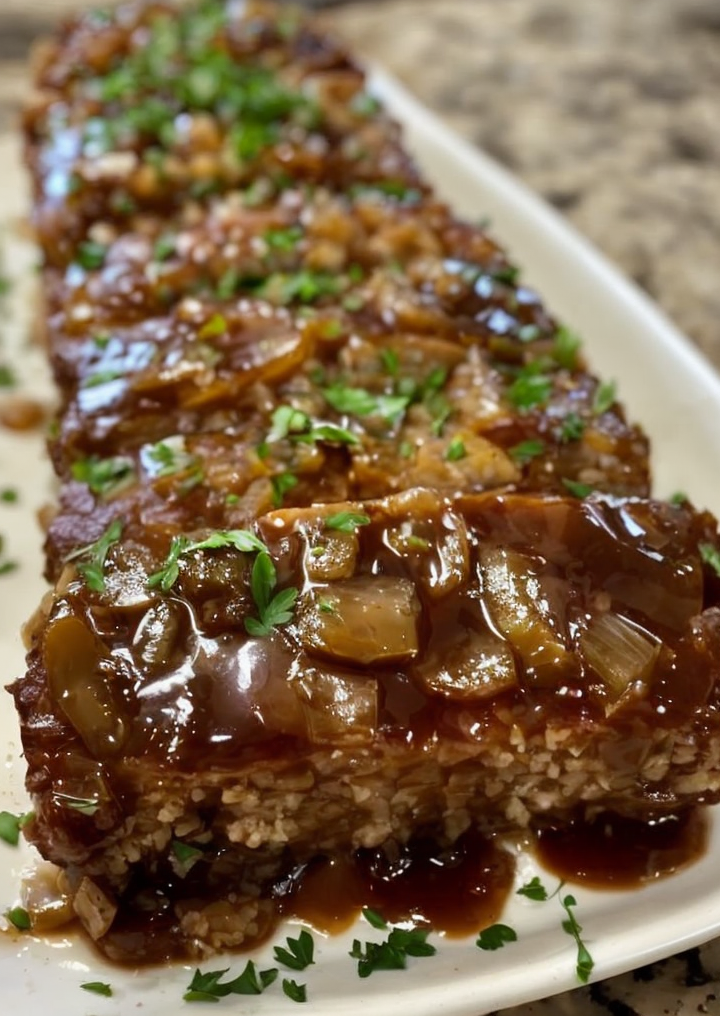Would You Eat This French Onion Meatloaf? A Garlic-Infused Delight
Experience a comforting twist on a classic meatloaf with our French Onion Meatloaf recipe, an absolute must-try for onion lovers. Infused with the rich, savory flavors of caramelized onions and a hint of garlic, this meatloaf transcends the everyday with its sophisticated profile. Each slice offers a juicy, tender bite balanced with undertones of herbs and spices, topped with an irresistibly golden crust that pairs perfectly with creamy mashed potatoes or a light green salad.
The comforting aroma fills your kitchen as it bakes, promising a meal that is both nostalgic and unique. Enhanced by subtle hints of thyme and Worcestershire sauce, this dish bridges traditional French onion flavor with the heartiness of meatloaf. The glossy, caramelized onion topping not only adds to the visual appeal but packs a welcoming aromatic kick that tantalizes the senses. Whether you’re hosting a dinner party or simply enjoying a family meal, this French Onion Meatloaf elevates the ordinary to extraordinary.
Quick Recipe Highlights
- Flavor Profile: A rich blend of savory caramelized onions harmonizing with the juicy meat, enriched by herbs and garlic.
- Texture: Enjoy a perfect balance of soft, tender meatloaf with a crispy, flavorful crust.
- Aroma: The kitchen fills with warm, inviting scents of onions and thyme.
- Visual Appeal: Dark golden crust crowned with glistening caramelized onions makes a mouth-watering presentation.
- Skill Level Needed: Intermediate—requires patience for caramelizing onions and attention to meatloaf consistency.
- Special Equipment: Cast iron skillet for best caramelization and a loaf pan for even baking.
Recipe Overview
- Difficulty Level: The recipe involves caramelizing onions, which demands patience and care to not rush or burn, while the meatloaf mixture requires precise seasoning to achieve depth of flavor.
- Category: This filling and flavorful dish fits squarely within main course accolades, promising to be the centerpiece of any meal.
- Cuisine: A fusion of traditional American comfort food with French culinary subtlety, brought together through the essence of onions.
- Cost: With affordable ingredients such as ground beef, onions, and bread crumbs, this recipe remains budget-friendly while delivering gourmet taste.
- Season: Best enjoyed in cooler months when comfort food is most craved, though applicable year-round for onion enthusiasts.
- Occasion: Ideal for family dinners, cozy gatherings, or holiday meals where warmth and flavor converge.
Why You’ll Love This Recipe
Savor the delightful harmony of rich flavors and textures in every bite of this French Onion Meatloaf. The intricate caramelization process of the onions adds an unparalleled depth of flavor, contrasting with the soft, moist interior created by the perfect blend of beef and fresh ingredients. It’s a taste sensation guaranteed to impress your guests.
Convenient for its make-ahead capabilities, this recipe not only saves time on busy nights but also enhances flavor as it sits. The meatloaf can be prepared and stored in the fridge ahead of time, simplifying meal planning for any occasion.
Nutritional benefits are notable with this dish’s use of onions, known for their vitamins and antioxidants, and beef for protein. Mixed herbs contribute further health perks, offering a dish that is as nutrients-dense as it is flavor-packed.
In social settings, this makes for an impressive centerpiece that pleases both traditionalists and adventurous eaters alike. Shared among friends, it turns a simple meal into a memorable experience, sparking conversation around its unique flavor infusion.
Financially accessible and easy to scale, this recipe can supply a crowd or sustain a smaller family affordably. Alternate vegetables or proteins invite creativity without compromising the satisfying taste of this fragrant meatloaf.
Historical Background and Cultural Significance
French Onion Meatloaf draws inspiration from the enduring popularity of French onion soup—a dish celebrated for its savory blend of caramelized onions and broth. Combining these honored flavors with meatloaf roots its appeal in comfort food lore.
In culinary history, the recipe serves as a modern evolution, merging two comfort classics into one. While meatloaf enjoys extensive Scandinavian and German lineage, the French onion twist reminds us of Europe’s intricate flavor fusions.
Culturally, this dish embodies the spirit of innovation within comfort cuisine, effortlessly adapting to modern palates while honoring its savory, rustic past. Regional variations further emphasize this adaptability, showcasing local ingredients and traditions.
Across various regions, you will find adaptations of this recipe employing distinct methods. Southern chefs might add a touch of barbecue sauce, while Northern cooks may embrace the sharpness of local cheeses, demonstrating its versatile spirit.
Ingredient Deep Dive
The highlight ingredient, onions, play an essential role in this dish, lending not just their sweetness but complex umami to the overall taste. Historically, onions are invaluable in many cuisines for their ability to enhance other flavors, offering both depth and body to the meatloaf.
Besides flavor, onions are nutrient powerhouses, boasting vitamins such as B6 and C, beneficial fiber, and health-supporting flavonoids. Look for firm, dry bulbs with no signs of sprouting for best quality in the supermarket. Store in a cool, dry place to prolong freshness.
Ground beef carries the heartiness in this recipe. For rich taste, choose a blend not too lean, such as 80/20, ensuring moisture retains throughout cooking. Nutritionally, it’s a robust protein source, important for maintaining muscle mass and promoting satiety in meals.
Common Mistakes to Avoid
- Avoid rushing the caramelization process; low and slow cooking of onions promises essential flavor depth.
- Don’t overlook seasoning in the meatloaf mixture—balanced seasoning is critical for flavor impact.
- Ensure thorough mixing, but avoid over-mixing which can make the meatloaf dense and tough.
- Failure to rest the cooked meatloaf before slicing can cause juices to escape, resulting in dryness.
- Use a thermometer to avoid undercooking or overcooking meat, ensuring ideal texture and safety.
- Choose the right size of loaf pan to prevent uneven cooking.
- Exclude excessive fillers such as breadcrumbs which can alter texture negatively.
- Skipping the resting period for caramelized onions might lead to an imbalance in flavor.
Essential Techniques
Caramelizing onions is pivotal, requiring both time and patience. The technique enriches the dish by developing deep, sweet-savory flavors as their sugars break down. Stir constantly, respond to color changes, and adjust heat to master this art without burning.
Forming the meatloaf correctly impacts the final texture. Gently mold into a cohesive loaf shape to ensure even cooking. Gentle handling avoids compressing the mixture, preserving moisture and tenderness.
Pro Tips for Perfect French Onion Meatloaf
For enhanced depth, deglaze the onions with a splash of white wine, allowing the alcohol to lift and meld any caramelized bits.
Experiment with cheese options; gruyere or Swiss melted on top add luxurious notes aligning with the French onion theme.
To prevent sticking, line the loaf pan with parchment paper, easing removal post-cooking.
Chill the meatloaf mix briefly before shaping—this helps maintain its structure during baking.
Maintain a steady oven temperature; frequent door opening can disrupt the cooking process, leading to dry edges.
Consider using a mix of beef and pork for a more complex flavor profile.
Variations and Adaptations
Regions with cheese afford selection flexibility; for instance, a sprinkling of local cheddar offers sharper notes cherished in some American adaptations.
In seasonal contexts, incorporating fresh herbs like spring-chervil or summer basil can provide lighter aromatic lifts.
Dieters often seek alternative fillers; grated zucchini or carrots work well in binding without gluten, appealing to gluten intolerances.
Flavor variations are easily achieved through additional herbs or spices, such as rosemary or paprika, to cater to personal palates.
Textural diversity can be introduced by integrating crushed nuts or seeds for crunch—popular among health-conscious consumers.
Present this dish with an elegant twist by utilizing ramekins for individual meatloaf portions, aligning with modern dining trends.
Serving and Presentation Guide
Traditional plating involves slices neatly aligned over creamy mashed potatoes, with onions generously ladled over each.
Consider garnishing with fresh parsley or chives, introducing a vibrant green contrast against the deep golden meatloaf.
Popular accompaniments include roasted vegetables or a tangy side salad, balancing the richness of the main dish.
For a modern presentation, staggered layering or deconstructed elements may intrigue the adventurous diner.
Temperature plays a role; serve warm for optimal taste, avoiding overlong exposure which dulls flavors.
Portion sizes should aim for satisfaction but avoid excess; one to two slices per person with side options maintains balance.
Wine and Beverage Pairing
Pairing this dish with a robust red wine like Cabernet Sauvignon accentuates its deep flavors, while a lighter white such as Sauvignon Blanc cuts through its richness.
For non-alcoholic alternatives, consider a tart cherry or cranberry juice, echoing the richness with fruity zest.
Tea aficionados may opt for Earl Grey or English Breakfast, with strong tannins contrasting the savory meatloaf character.
Serve all beverages slightly chilled to embolden their respective aromas and contribute to a refreshing overall dining experience.
Storage and Shelf Life
Store leftover meatloaf in an airtight container in the refrigerator, ensuring it remains moist and flavorful for up to five days.
Keep the temperature consistently cool, ideally below 40°F, to maintain freshness and safety.
Use sealed bags or vacuum containers to avoid airflow and prolong shelf life—ideal for preserving tender morsels.
Watch for discoloration or off-smells as spoilage indicators, prompting disposal when noticed.
Reheat gently in the oven or microwave, considering adding moisture such as a broth splash to prevent dryness.
Meatloaf freezes well; slice before freezing for easy portioning later, wrapping tightly in foil or freezer paper.
Make Ahead Strategies
Prepare onions and meat mixture separately ahead of time, storing them individually until assembly, enhancing flavor depth without rushing.
Storing dough between these steps guarantees flavors meld, improving the final taste upon baking.
Evaluate quality impact based on ingredient freshness; fresher herbs and meats yield improved culinary outcomes.
For best results, assemble the meatloaf the night before cooking; this consolidated structure prevents coarseness and cradles flavors.
Reheat gently before serving while prioritizing fresh toppings like raw onions or herbs to revitalize flavor and presentation.
Scaling Instructions
To halve or scale up the recipe, adapt proportions carefully, ensuring the meat-loaf structure remains coherent and seasoned correctly.
Adjust equipment based on size; larger pans require more attentive heat distribution for even cooking.
Monitor timing intricacies—larger loaves may need increased bake times for thorough cooking, necessitating thermometer verification.
Keep storage considerations in mind, particularly when expanding batches, as extended storage may impact ingredient freshness.
Nutritional Deep Dive
Examine the macro ratios in this meatloaf—high in protein and moderate in fats due to beef, while onions contribute carbohydrates.
Micronutrient-rich, onions furnish essential vitamins and minerals alongside health-promoting antioxidants.
Portion discretion aligns with dietary advisories; consume moderate slices to manage caloric intake effectively.
For those intrigued by nutritional flexibility, hone in on portion control, ensuring balance across fat and protein-intake in meals.
Dietary Adaptations
For gluten-free interpretations, substitute bread crumbs with gluten-free oats or crackers, maintaining texture without gluten.
Create a dairy-free version by omitting cheese toppings or substituting with dairy-free options, aligning with dietary needs.
Vegan adaptations lean on lentils or chickpeas for protein and flax or chia seeds for binding, freeing the dish from animal products.
Low-carb enthusiasts might replace breadcrumbs with almond or chickpea flour, preserving the loaf’s structure while moderating carb content.
Explore keto alternatives with added fats like bacon or a cheese crust, sticking within the ketone diet framework.
Paleo considerations swap processed components for natural substitutes like almond meal, adhering to Paleolithic dietary principles.
For low-FODMAP adjustments, ensure onion is abbreviated or replaced with green onion tops, minimizing digestive discomfort.
The Recipe
French Onion Meatloaf
Serves: 6
Prep Time: 20 mins
Cook Time: 1 hr 30 mins
Total Time: 1 hr 50 mins
Kitchen Equipment Needed
- Cast iron skillet
- Baking loaf pan
- Mixing bowls
- Thermometer
Ingredients
- 1 ½ pounds ground beef
- 2 large onions, thinly sliced
- 2 cloves garlic, minced
- 1 cup breadcrumbs
- 2 eggs
- 1 cup beef broth
- 1 tablespoon Worcestershire sauce
- 1 teaspoon thyme
- Salt and pepper to taste
- Olive oil for sautéing
Directions
- Preheat your oven to 350°F (175°C).
- In a skillet, heat olive oil over medium heat and add onions. Sauté until caramelized, about 15-20 minutes. Add garlic and cook for an additional minute.
- In a large bowl, combine ground beef, breadcrumbs, eggs, broth, Worcestershire sauce, thyme, and half of the caramelized onions. Mix softly to combine.
- Season mixture with salt and pepper, then shape into a loaf and place in a prepared baking pan.
- Top meatloaf with the remaining caramelized onions.
- Bake in the preheated oven for 1 hour and 30 minutes, or until the internal temperature reaches 160°F (70°C).
- Rest the meatloaf for 10 minutes before slicing and serving.
Recipe Notes
- For extra flavor, top with shredded cheese during the last 15 minutes of baking.
- Consider incorporating one chopped green bell pepper for added texture and flavor.
Troubleshooting Guide
For texture issues, ensure that you are not overmixing the meat mixture which can make it tough. If your meatloaf ends up too crumbly, try adding additional egg or more breadcrumbs to help bind it.
When struggling with flavor balance, remember that seasoning can be adjusted to taste during preparation. Adding more spices such as thyme or extra Worcestershire sauce can enhance flavor depth.
Monitor cooking temperatures closely to avoid overcooking, which can lead to dryness. Familiarize yourself with your oven’s heat distribution for even cooking outcomes.
Ingredient substitutions can cause inconsistencies; whenever exchanging components like breadcrumbs or herbs, adjust quantities to sustain the intended texture and taste.
Test different timing strategies; pre-mixing the ingredients and allowing them to sit can ensure better flavor absorption.
Recipe Success Stories
Our readers rave about the comforting blend of flavors this recipe provides, often sharing how they incorporate it into family gatherings or holiday celebrations. Many have successfully adapted the dish with different proteins or additional vegetables, touting its versatility.
Photographs shared by the community demonstrate colorful variations—bell peppers, mushrooms, and even jalapeños reflect reader creativity and cuisine personalization.
Reader suggestions suggest experimenting with condiments or baked inclusions, such as adding diced tomatoes atop the meatloaf for a brighter finish.
Frequently Asked Questions
Broil the meatloaf briefly after baking to crisp up the top, ensuring you carefully monitor to avoid burning.
Can I use ground turkey instead of beef?
Yes, ground turkey is a viable substitute, though the flavor profile will differ slightly. Ensure the turkey is well seasoned.
What can I serve on the side?
Popular side dishes include mashed potatoes, steamed broccoli, or a refreshing coleslaw. These complement the savory meatloaf perfectly.
Is it okay to freeze leftover meatloaf?
Absolutely, slice into portions for easy reheating. Properly wrapped, it keeps well for two to three months in the freezer.
Can I make this recipe in advance?
Yes, prep the mixture and store it covered in the fridge for up to 24 hours before baking. This infuses more flavor into the meatloaf.
What if I don’t have Worcestershire sauce?
Substitute with soy sauce or a mix of soy sauce and a dash of balsamic vinegar to emulate the savory undertones Worcester provides.
How do I know when the meatloaf is fully cooked?
The loaf is done when its internal temperature reaches 160°F (70°C). Use a meat thermometer to confirm accuracy.
Are there low-carb options for the breadcrumbs?
Crushed pork rinds or almond flour can be employed instead of breadcrumbs to reduce carbohydrate content.
What is the secret to moist meatloaf?
Incorporating enough moisture-making ingredients such as eggs, broth, or grated vegetables ensures a juicy texture. Avoid overbaking.
Does this recipe accommodate larger gatherings?
Indeed, it scales well, just adjust ingredient quantities proportionally and use multiple loaf pans to manage cooking times.
Additional Resources
For enthusiasts willing to explore further, related recipes like classic meatloaf, beef Wellington, or shepherd’s pie provide insight into similar flavor profiles and cooking techniques.
Technique guides focusing on caramelization or loaf formation can refined skills relevant to this dish and beyond, enhancing culinary understanding.
Explore comprehensive ingredient information highlighting the nutritional and historical context of onions and beef within global cuisines.
Consider equipment recommendations for ensuring pan sizes or thermometers best fit baking needs.
Seasonal variations of this recipe encourage use of fresh, accessible produce, demonstrating adaptability across different regional markets.
Join the Conversation
Engage with fellow cooking enthusiasts by sharing recipes and successes on social media platforms, using tags like #FrenchOnionMeatloaf or #ComfortFood.
Photography tips can help you capture the perfect slice or dinner presentation, showcasing this dish’s savory beauty.
Contribute reviews or comments detailing your family’s feedback or personal adaptations; community engagement enriches the cooking experience.
Experiment with recipe variations and share your discoveries, encouraging a vibrant dialogue around this innovative meatloaf.



